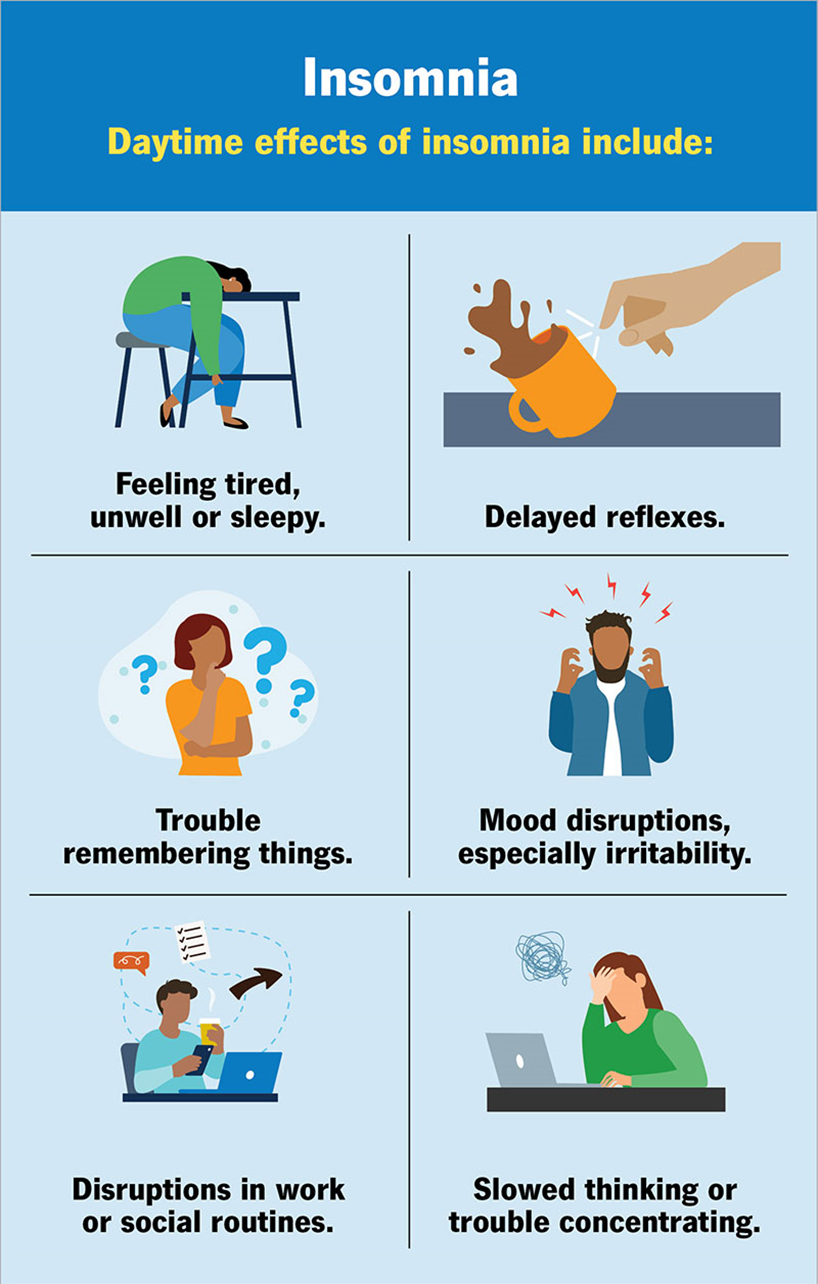A nurse is assessing a client who has chronic insomnia. Which question would address the highest safety priority for the client?
When did you begin to have trouble sleeping?
Are there any specific factors that you think are affecting your ability to sleep?
Do you have difficulty staying awake when you are driving?
Can you describe your bedtime routine to me?
The Correct Answer is C
Choice A Reason:
Asking “When did you begin to have trouble sleeping?” is important for understanding the onset and duration of the client’s insomnia. However, it does not directly address immediate safety concerns. Chronic insomnia can lead to significant daytime impairment, but the question about the onset of sleep troubles does not identify specific safety risks.
Choice B Reason:
Inquiring about specific factors affecting the client’s ability to sleep can help identify potential causes of insomnia, such as stress, environmental factors, or medical conditions. While this information is valuable for treatment planning, it does not directly address immediate safety concerns.
Choice C Reason:
Asking “Do you have difficulty staying awake when you are driving?” addresses the highest safety priority. Chronic insomnia can lead to excessive daytime sleepiness, which significantly increases the risk of accidents, especially while driving. Identifying whether the client is at risk of falling asleep during potentially dangerous activities is crucial for immediate safety.

Choice D Reason:
Understanding the client’s bedtime routine can provide insights into their sleep hygiene and habits, which are important for managing insomnia. However, this question does not directly address immediate safety concerns related to daytime functioning and the risk of accidents.
Nursing Test Bank
Naxlex Comprehensive Predictor Exams
Related Questions
Correct Answer is ["A","C","D","E"]
Explanation
Choice A Reason:
Cured fat foods, such as bacon, sausages, and other processed meats, are high in saturated fats and sodium. Consuming these foods in excess can lead to increased cholesterol levels and a higher risk of heart disease. Limiting these foods is essential for maintaining a healthy diet and reducing the risk of chronic diseases.
Choice B Reason:
Vegetables are generally low in calories and high in essential nutrients, including vitamins, minerals, and fiber. They are an important part of a balanced diet and should not be limited. Instead, increasing vegetable intake is often recommended for better health outcomes.
Choice C Reason:
Canned soups often contain high levels of sodium, which can contribute to high blood pressure and other cardiovascular issues. Limiting the intake of canned soups can help manage sodium consumption and promote better heart health.
Choice D Reason:
Processed snacks, such as chips, crackers, and packaged baked goods, are typically high in unhealthy fats, sugars, and sodium. These foods can contribute to weight gain, high blood pressure, and other health problems. Reducing the intake of processed snacks is beneficial for overall health.
Choice E Reason:
Sugary drinks, including sodas, fruit juices with added sugars, and energy drinks, are high in calories and can lead to weight gain and increased risk of type 2 diabetes. Limiting sugary drinks is crucial for maintaining a healthy weight and preventing chronic diseases.
Correct Answer is C
Explanation
Choice A reason: While chest physiotherapy can help mobilize secretions, it does not specifically promote the flow of secretions to the base of the lungs. The primary goal is to loosen and mobilize secretions so they can be coughed up and cleared from the airways. This helps improve overall lung function and oxygenation.
Choice B reason: Chest physiotherapy does not eliminate the need to cough. In fact, coughing is an essential part of the process as it helps expel the loosened secretions from the airways. The therapy aims to make coughing more effective by loosening the mucus.
Choice C reason: The primary purpose of chest physiotherapy with percussion and vibration is to help clear the airways of excessive secretions. This is particularly important for patients with conditions like chronic obstructive pulmonary disease (COPD), cystic fibrosis, or pneumonia, where mucus buildup can obstruct the airways and impair breathing. By loosening and mobilizing the secretions, the therapy facilitates their removal through coughing.
Choice D reason: Chest physiotherapy does not limit the production of bronchial mucus. It focuses on clearing existing mucus from the airways rather than reducing its production. The production of mucus is influenced by underlying conditions and may require other treatments to manage.
Whether you are a student looking to ace your exams or a practicing nurse seeking to enhance your expertise , our nursing education contents will empower you with the confidence and competence to make a difference in the lives of patients and become a respected leader in the healthcare field.
Visit Naxlex, invest in your future and unlock endless possibilities with our unparalleled nursing education contents today
Report Wrong Answer on the Current Question
Do you disagree with the answer? If yes, what is your expected answer? Explain.
Kindly be descriptive with the issue you are facing.
